Reliable detection in repeatability 10 μm 0.394 mil*
* HG-C1030□


UL/C-UL , CE , FDA Approved
![]() This product is classified as a Class 2 Laser Product under IEC / JIS / GB standards and FDA regulations. Do not look at the laser beam directly or through an optical system such as a lens.
This product is classified as a Class 2 Laser Product under IEC / JIS / GB standards and FDA regulations. Do not look at the laser beam directly or through an optical system such as a lens.
* This product complies with 21 CFR 1040.10 and 1040.11 Laser Notice No. 50, dated June 24, 2007, issued by CDRH (Center for Devices and Radiological Health) under the FDA (Food and Drug Administration).
Features

Equipped with 0 to 5 V analog output and 4 to 20 mA analog current output
The value can be measured with a distance measurement sensor.
・ Linearity:±0.1%F.S.*1
・ Temperature characteristics:0.03 %F.S./℃
*1 : HG-C1030(-P)/HG-C1050(-P)/HG-C1100(-P)

<Compact>
The smallest CMOS laser sensor in the industry*
*Based on research conducted by our company as of July 2022
A new optical system with a built-in mirror
In general, more accurate and stable measurements can be obtained by increasing the optical path length between the light-receiving part and the light receiving element (CMOS), but this also increases the sensor depth and the sensor body gets bigger. The HG-C series sensors incorporating a new optical system with a built-in mirror provides smaller sensor depth as well as higher measurement accuracy equivalent to displacement sensors.
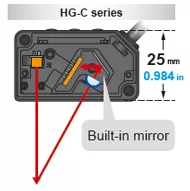
An aluminum die-cast casing protects from strain and heat
A light-weight but strong die-cast aluminum casing has been adopted. A compact, solid body casing reduces the impact of strain and heat on the measurement accuracy.
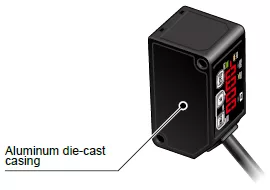
Precise measurements on the order of 1/100 mm 0.0003 inch*
* HG-C1030□
Fitted with a precise CMOS image sensor and an original algorithm
Thanks to a precise CMOS image sensor, it is now possible to perform highly precise measurements in the order of 1/100 mm 0.0003 in. The existing adjustable range reflective sensors cannot achieve such accuracy.

Useful functions
Teaching & window comparator mode
Normal sensing mode
[2-Point teaching]
Basic teaching method
The threshold value is set automatically at the midpoint between the two points specified by teaching.
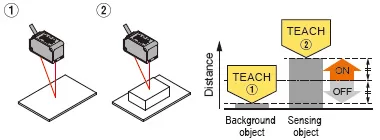
[Limit teaching]
Useful teaching method for when there is a very small object or background object.
<When using background object as reference>
When the sensing object is located closer to the sensor than the background object, the threshold value for detection is set. This function is useful when there is a change in the size of sensing object.

<When using sensing object as reference>
The threshold value is set on the background object side with reference to the sensing object. Use this method when there is a long distance to the background object.

Window comparator mode
With an object below the sensor, press the TEACH key to set the valid range for distances via threshold values. There are 3 methods for setting the valid range: 1-point, 2-point, and 3-point teaching.
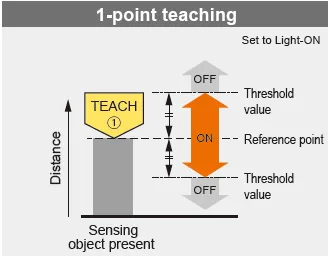
Perform 1-point teaching and the threshold range is set for the distance from the reference surface of the sensing object.
This is used for sensing within the threshold range.
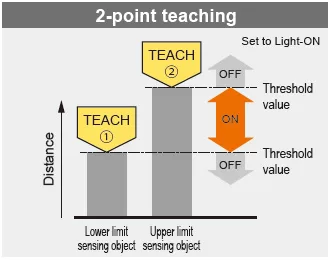
Press TEACH once for the lower (first point) and once for the upper limit (second point).
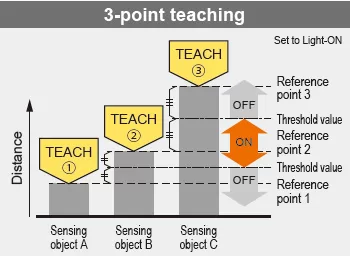
This is the method to set the threshold range by conducting the teaching at 3 points (sensing object A, B and C). After teaching, the reference points are automatically sorted in ascending order (reference point 1, 2 and 3). The thresholds are set at the midpoints between reference point 1 and 2, and 2 and 3, respectively.
Rising differential mode / Trailing differential mode
Use this mode to cancel gradual changes in the measured value and to detect only sudden changes. For the setting of threshold value, use the threshold value fine adjustment function.
Timer setting function
The time mode options are “off-delay timer,” “on-delay timer,” “one-shot timer” and “no timer.” The counting time is fixed to 5 ms.

Timer period: 5 ms (fixed)
Off-delay timer
Function : Extends output signals by 5 ms.
Usage : Appropriate in case a connected device is slow to respond and ON time is required to extend.
On-delay timer
Function: Overrides output signals for 5 ms after detection.
Usage: Convenient way to override temporary signals and control with a time lag.
One-shot timer
Function: Sends output signals for only 5 ms after detection.
Usage: Useful when the signal duration needs to be constant to meet inputs from a connected device.
This mode is also used to extend temporary signals by a desired length of time.
Zero set function
This function compulsorily sets the measured value to “zero.”
The zero point can be set at a desired value. It is useful when measuring steps or tolerance with reference to the height of a sensing object.
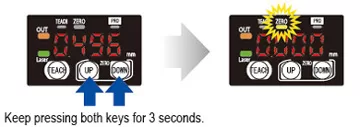
* The zero set indicator (yellow) will turn ON while the zero set is valid.
* When the zero set function is executed while the peak hold function or the bottom hold function is valid, the held measurement value is reset.
* When the display setting is set to offset, the zero set function cannot be set.
External input setting function
One of four functions, “zero setting function,” “teaching function,” “emission stopping function” and “trigger function” can be assigned to an external input line.

Display setting function
How to indicate measured values of the moving sensed object can be chosen from three options, “Normal,” “Invert” and “Offset.”
Example:HG-C1050(-P)
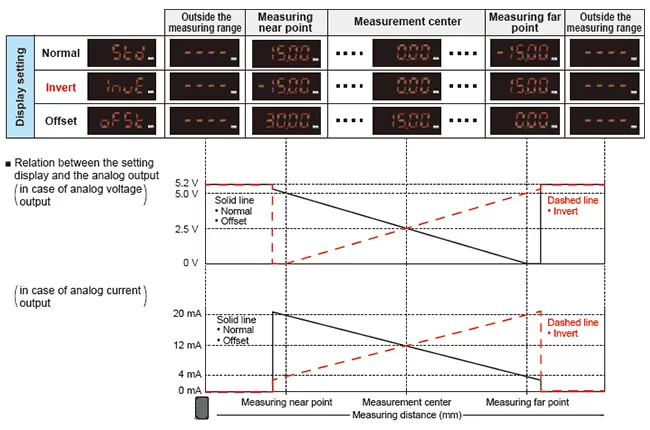
Peak and bottom hold functions
The peak hold function holds the maximum measured value which is output and displayed.
The bottom hold function holds the minimum measured value which is output and displayed.
* The peak hold function and the bottom hold function cannot be set at the same time.
* When the zero set function is executed while the peak hold function or the bottom hold function is valid, the held measurement value is reset.
Threshold value fine adjustment function
Fine adjustment of threshold values can be performed while measurement is proceeding on the display, and even after teaching.
Key lock function
This function protects setting conditions from unintentional changes.
* For other functions and procedures for setting the functions, see the instruction manual provided with the product.
Order guide
| Type | Appearance | Measurement center distance and measurement range | Repeatability | Beam diameter (Note 1) |
Model No. | |
|---|---|---|---|---|---|---|
| NPN output | PNP output | |||||
| Measurement center 30mm 1.181 in type |  |
30±5mm 1.181 ± 0.197 in |
10μm 0.394 mil |
ø50μm 1.969 mil approx. |
HG-C1030 | HG-C1030-P |
| Measurement center 50mm 1.969 in type |
50±15mm 1.969 ± 0.591 in |
30μm 1.181 mil |
ø70μm 2.756 mil approx. |
HG-C1050 | HG-C1050-P | |
| Measurement center 100mm 3.937 in type | 100±35mm 3.937 ± 1.328 in |
70μm 2.756 mil |
ø120μm 4.724 mil approx. |
HG-C1100 | HG-C1100-P | |
| Measurement center 200mm 7.874 in type | 200±80mm 7.874 ± 3.150 in |
200μm 7.874 mil |
ø300μm 11.811 mil approx. |
HG-C1200 | HG-C1200-P | |
| Measurement center 400mm 15.748 in type | 400±200mm 15.748 ± 7.874 in |
300 μm 11.811 mil (Measuring distance 200 to 400 mm 7.874 to 15.748 in) 800 μm 31.496 mil (Measuring distance 400 to 600 mm 15.748 to 23.622 in) |
ø500μm 19.685 mil approx. |
HG-C1400 | HG-C1400-P | |
Note 1: This is the size in the measurement center distance. These values were defined by using 1/e2 (13.5% approx.) of the center light intensity.
Due to leak light outside the specified area, the reflectance around the detecting point may be higher than at the point and this may affect the measurement value.

